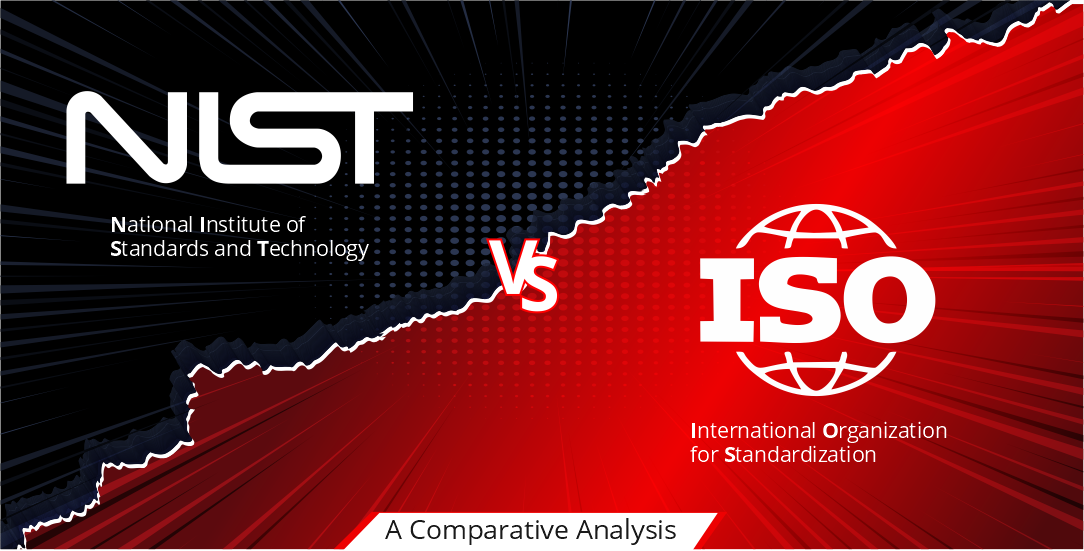NIST vs ISO: A Comparative Analysis
Today, we can find mature frameworks complex laws, and regulations globally that businesses must comply with to maintain their systems, network, and data security. National Institute of Standards and Technology Cyber Security Framework (NIST CSF) and ISO 27001 are two of the most common ones followed in North America and Europe.
These structures strive to preserve data, present a more robust security condition, and have unique ways of operability. Here, we take a close and comparative look at their similarities and distinctions to enable you to make an informed business decision.
Explaining NIST CSF:
NIST- The National Institute of Standards and Technology issues a voluntary set of guidelines for businesses to maintain and subdue cybersecurity risks. The Cybersecurity Framework (CSF) is for companies of all sizes and domains and is very much customizable.
NIST CSF was built to recognize and systematize explicit controls and procedures. A majority of them have already been incorporated and replicated in the current frameworks. It advances further but does not fully substitute security standards such as NIST 800-53 or ISO 27001. NIST CSF is an excellent option if you are looking for ways to optimize your cybersecurity on a budget.
How About ISO 27001?
ISO, the International Organization for Standardization in association with the International Electrotechnical Commission (IEC), issues ISO 27001, which is a globally recognized standard. It stipulates provisions for establishing, implementing, managing, and constantly upgrading an information security management system (ISMS). Any company that gathers sensitive data, big or small, public or private, profit or non-profit, can forward their business using an ISO implementation. A few vendors may need some organizations to obtain certification before initiating an effective relationship. However, many organizations still seek ISO 27001 by sole preference.
The Overlap: NIST CSF and ISO 27001
NIST CSF and ISO 27001 are parallel structures that demand superior management care, uninterrupted growth, and risk-centric plans. The risk management structure for both NIST and ISO is identical too. The three fundamental steps for risk management are:
- Classify risks to the company’s cognizance
- Execute controls relevant to the identified risk
- Track the performance
A vital overlap area is linked to managing an asset record as identified by Annex A.8.1 of ISO 27001 for asset responsibility of NIST CSF for asset management.
The Contrasts: NIST CSF and ISO 27001
There are some striking disparities between NIST CSF and ISO 27001. NIST (CSF) was formulated to support US federal agencies and corporations in better risk management. On the other hand, ISO 27001 is a globally accepted system for building and sustaining an ISMS (Information Security Management System). It includes auditors and certifying groups, while NIST CSF is voluntary. NIST is a self-certification framework that is universally acknowledged.
NIST structures have multiple control programs and five functions to personalize cybersecurity controls. At the same time, ISO 27001 Annex A presents 14 control categories with 114 rules and 10 management clauses to lead businesses through their ISMS.
ISO 27001 is relatively less technical, featuring more on risk-centric management that offers best-practice references to guard all data. ISO 27001 extends a valid certification option for businesses that hold operational capability, while the NIST CSF can be best fitted for companies in the beginning stages of realizing a cybersecurity risk program or striving to lessen security encroachments.
The Pricing: NIST CSF and ISO 27001
NIST CSF document is obtainable free of charge as it is primarily voluntary. Implementation can be performed at a decided speed and cost. Nevertheless, as ISO 27001 requires audits and certification, there’s usually a larger price. ISO certification is legitimate for three years, and businesses are expected to perform inspection audits for two years, during the third year, they will achieve a recertification audit.
So small-sized and greenfield companies will typically get off the ground for their InfoSec program with NIST and scale their way towards ISO 27001 as they expand their base and presence.
The Conclusive Complementarity: NIST CSF and ISO 27001
Both of the regulatory frameworks undertake data security and risk management from varying standpoints and include diverse scopes. Recognize the intrinsic risks in your data systems, possible resources, and whether or not you possess a currently operational data security strategy.
Performing a NIST audit on your own delivers an idea of the status of your existing cybersecurity program. Based on the audit results, you can make an educated decision before contracting and executing an exceedingly distinguished framework such as ISO 27001.
